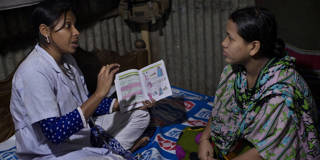DHAKA – En salud pública, los debates en torno a las mujeres suelen darse en torno a la mortalidad materna, la desnutrición y, más recientemente, la salud sexual y reproductiva. Pero a menudo se ignora una faceta de la desnutrición que causa la muerte de gran cantidad de mujeres: la anemia.
La anemia es el desorden nutricional más común en el planeta, afectando a más de 1,6 millones de personas. En su definición amplia como una concentración demasiado baja de hemoglobina (proteína rica en hierro que transporta oxígeno a los tejidos del cuerpo) en la sangre, ocurre cuando no hay suficientes glóbulos rojos o se ve afectada su capacidad de transportar oxígeno. Su causa es la deficiencia de nutrientes esenciales, a menudo hierro, pero también ácido fólico, vitamina B12 o vitamina A.
Si bien cualquiera puede tener anemia, la mayoría de los afectados son mujeres en edad reproductiva: en 2011, un 29% de las mujeres no embarazadas del mundo (496 millones de personas) y un 38% de las embarazadas (32,4 millones de personas) de entre 15 y 29 años la padecían. Este trastorno era más prevalente en el sur de Asia y África central y occidental.



DHAKA – En salud pública, los debates en torno a las mujeres suelen darse en torno a la mortalidad materna, la desnutrición y, más recientemente, la salud sexual y reproductiva. Pero a menudo se ignora una faceta de la desnutrición que causa la muerte de gran cantidad de mujeres: la anemia.
La anemia es el desorden nutricional más común en el planeta, afectando a más de 1,6 millones de personas. En su definición amplia como una concentración demasiado baja de hemoglobina (proteína rica en hierro que transporta oxígeno a los tejidos del cuerpo) en la sangre, ocurre cuando no hay suficientes glóbulos rojos o se ve afectada su capacidad de transportar oxígeno. Su causa es la deficiencia de nutrientes esenciales, a menudo hierro, pero también ácido fólico, vitamina B12 o vitamina A.
Si bien cualquiera puede tener anemia, la mayoría de los afectados son mujeres en edad reproductiva: en 2011, un 29% de las mujeres no embarazadas del mundo (496 millones de personas) y un 38% de las embarazadas (32,4 millones de personas) de entre 15 y 29 años la padecían. Este trastorno era más prevalente en el sur de Asia y África central y occidental.